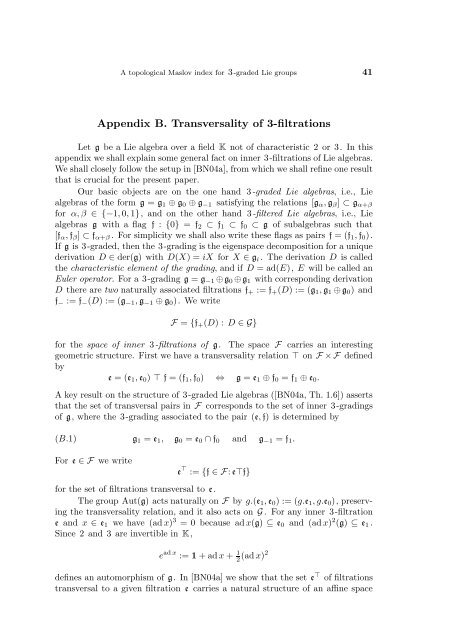A topological Maslov index for 3-graded Lie groups - ResearchGate
A topological Maslov index for 3-graded Lie groups - ResearchGate
A topological Maslov index for 3-graded Lie groups - ResearchGate
You also want an ePaper? Increase the reach of your titles
YUMPU automatically turns print PDFs into web optimized ePapers that Google loves.
A <strong>topological</strong> <strong>Maslov</strong> <strong>index</strong> <strong>for</strong> 3-<strong>graded</strong> <strong>Lie</strong> <strong>groups</strong> 41<br />
Appendix B. Transversality of 3-filtrations<br />
Let g be a <strong>Lie</strong> algebra over a field K not of characteristic 2 or 3. In this<br />
appendix we shall explain some general fact on inner 3-filtrations of <strong>Lie</strong> algebras.<br />
We shall closely follow the setup in [BN04a], from which we shall refine one result<br />
that is crucial <strong>for</strong> the present paper.<br />
Our basic objects are on the one hand 3-<strong>graded</strong> <strong>Lie</strong> algebras, i.e., <strong>Lie</strong><br />
algebras of the <strong>for</strong>m g = g1 ⊕ g0 ⊕ g−1 satisfying the relations [gα, gβ] ⊂ gα+β<br />
<strong>for</strong> α, β ∈ {−1, 0, 1}, and on the other hand 3-filtered <strong>Lie</strong> algebras, i.e., <strong>Lie</strong><br />
algebras g with a flag f : {0} = f2 ⊂ f1 ⊂ f0 ⊂ g of subalgebras such that<br />
[fα, fβ] ⊂ fα+β . For simplicity we shall also write these flags as pairs f = (f1, f0).<br />
If g is 3-<strong>graded</strong>, then the 3-grading is the eigenspace decomposition <strong>for</strong> a unique<br />
derivation D ∈ der(g) with D(X) = iX <strong>for</strong> X ∈ gi. The derivation D is called<br />
the characteristic element of the grading, and if D = ad(E), E will be called an<br />
Euler operator. For a 3-grading g = g−1 ⊕g0 ⊕g1 with corresponding derivation<br />
D there are two naturally associated filtrations f+ := f+(D) := (g1, g1 ⊕g0) and<br />
f− := f−(D) := (g−1, g−1 ⊕ g0). We write<br />
F = {f+(D) : D ∈ G}<br />
<strong>for</strong> the space of inner 3-filtrations of g. The space F carries an interesting<br />
geometric structure. First we have a transversality relation ⊤ on F × F defined<br />
by<br />
e = (e1, e0) ⊤ f = (f1, f0) ⇔ g = e1 ⊕ f0 = f1 ⊕ e0.<br />
A key result on the structure of 3-<strong>graded</strong> <strong>Lie</strong> algebras ([BN04a, Th. 1.6]) asserts<br />
that the set of transversal pairs in F corresponds to the set of inner 3-gradings<br />
of g, where the 3-grading associated to the pair (e, f) is determined by<br />
(B.1) g1 = e1, g0 = e0 ∩ f0 and g−1 = f1.<br />
For e ∈ F we write<br />
e ⊤ := {f ∈ F: e⊤f}<br />
<strong>for</strong> the set of filtrations transversal to e.<br />
The group Aut(g) acts naturally on F by g.(e1, e0) := (g.e1, g.e0), preserving<br />
the transversality relation, and it also acts on G. For any inner 3-filtration<br />
e and x ∈ e1 we have (ad x) 3 = 0 because ad x(g) ⊆ e0 and (adx) 2 (g) ⊆ e1.<br />
Since 2 and 3 are invertible in K,<br />
e ad x := 1 + adx + 1<br />
2 (ad x)2<br />
defines an automorphism of g. In [BN04a] we show that the set e ⊤ of filtrations<br />
transversal to a given filtration e carries a natural structure of an affine space

















